This was my very first Interaction lab recitation, and hearing that we will be working on building something by ourselves makes me very excited. Soon after I grouped up with other two girls, we started to work on hands.
We started by building the switch. First, we cut down the cardboard by 5×8, and then we sticked copper tape at one of the narrow edges of the board. After that we stripped the ends of two wires, which was pretty hard unexpectedly. Then came the most exciting part, soldering!! I found it very interesting to flow the solder and stabilize the wires. Afterwards, by combining two folded cardboard with my partner, the switch was ready.
.

Then we moved on to build the circuit. It took us a while to recognize all those elements, and then we just started to connect them all together according to the sketch map. At first, we didn’t connect the electricity for every step, we connected it after we built the whole circuit, sadly, the LED wasn’t lightened. We tried to examine the circuit but there were too many elements and wires and made it very hard to check, so that we got to disassemble it. The second time we built it, we connected it with electricity after every single step to make sure that we were doing things right. And this time it worked fluently. Then we changed the Push-Button Switch into the one we built previously, it also worked well. That gave us a great sense of achievement.
Question1:
I think the use of the resister R1 is to control the current that passes through the LED and to protect the LED from burning out.
Question2:

Question3:
I think the circuit we built interacted with us, because it responds to our action of pressing the switch we built in the way of buzzing and lighting up the LED. However, it’s response was relatively calm and didn’t have a very intense effect, it just shows that the circuit works. So that I think the degree of interactivity is low.
Question4:
I think in order to create Interactive art, there are two parts. One of them is about creating, and the other is about interactive art. For the first part, it needs the help of Physical Computing, for this “interaction” happens between human and computer; and for the second, part, it requires interaction designing to not only provide interactive ideas but also design interactive ways. According to Zack Lieberma and the painting installation he built, the building process is the process of Physical Computing, however the entertainment effect it provides and the unique way human and computer interact with each other come from Zack and his co-workers’ interaction design. So those two elements are both important and indispensable to creating interactive art, and they need to be blended together to present as one.